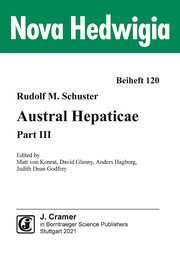Detailansicht
Austral Hepaticae, Part III
Nova Hedwigia, Beihefte 120
ISBN/EAN: 9783443510428
Umbreit-Nr.: 569861
Sprache:
Englisch
Umfang: XIII, 721 S., 225 Abb.
Format in cm:
Einband:
kartoniertes Buch
Erschienen am 07.01.2021
Auflage: 1/2021
- Zusatztext
- This third and voluminous (Set of volumes I-III available at nice price) final volume of Schuster's Austral Hepaticae treats two large families: Geocalyaceae (including Lophocoleoideae), Plagiochilaceae, and several smaller families including Acrobolbaceae and Balantiopsidaceae. This volume completes the comprehensive and significant evolutionary-systematic research program completed by Professor Schuster which began in the mid-1950s and revolutionised our understanding of both relationships and diversity in liverworts. His legacy is a classification that remains recognisable as largely his, particularly at deeper phylogenetic levels. Professor Schuster had strong views on character evolution, and framed his interpretation of character evidence and relationships in accordance with these. </p> <p> The enduring value of Schusters work, despite some revision of our understanding of relationships wrought by molecular phylogenetic investigations, lies in the wealth of astute observation and superb illustration of morphology and anatomy completed by Professor Schuster. As a compendium of morphological character data the three parts of Austral Hepaticae are unsurpassed, and will be particularly valuable as morphological and molecular data are synthesised in future studies of character evolution in the hepatics. </p> <p> Professor Schuster was possibly the last hepaticologist to have such a detailed and world-wide understanding of these families and was able, as a single individual, to produce a coherent and comprehensive classificatory scheme that encompasses all leafy liverworts. For regional workers on the hepatic flora this work provides a broad, cohesive, and synthetic overview of relationships, which serves the dual purpose of facilitating identification of the plants, in addition to communicating hypotheses regarding their relationships.
